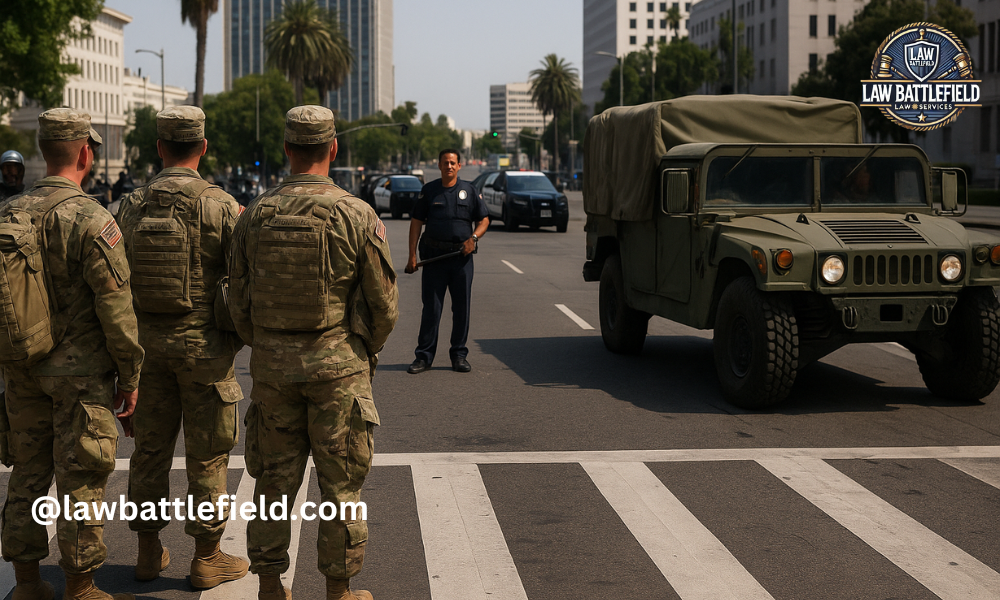In 2025, a high-stakes legal battle has captured national attention: the California National Guard federalization lawsuit, formally known as Newsom v. Trump. At its heart, the case tests a fundamental constitutional question — how far can a president go in using state military forces without a governor’s consent?
The dispute began when former President Donald Trump ordered the federalization of thousands of California National Guard troops during immigration-related protests in Los Angeles. Governor Gavin Newsom quickly pushed back, arguing that the move violated both federal law and the U.S. Constitution. What followed is a clash between presidential authority and state sovereignty, with potential consequences for how the military can be used inside U.S. borders.
Key legal frameworks shape this case. The Posse Comitatus Act restricts the military from performing domestic law enforcement. The Tenth Amendment protects states’ rights against federal overreach. And 10 U.S.C. § 252 gives the president power to federalize the Guard under limited circumstances, such as rebellion or when laws cannot otherwise be enforced. Together, these provisions frame the central question: did the federalization in California cross a constitutional line, or was it a lawful exercise of presidential power?
Background Context
The dispute over the California National Guard federalization lawsuit cannot be understood without looking at what unfolded in Los Angeles during June 2025. A surge of immigration-related protests, a controversial federal order to take control of state troops, and a rapid legal response from Governor Gavin Newsom all combined to spark one of the most consequential constitutional battles of the decade.
What Happened In June 2025
In early June 2025, Los Angeles saw days of mass protests against federal immigration raids. While largely peaceful, scattered clashes raised political alarm. On June 8, former President Donald Trump ordered the federalization of about 4,000 California National Guard members and the deployment of 700 Marines.
Once federalized, Guard units began operating checkpoints, blocking streets, and assisting in detentions. Governor Gavin Newsom rejected the move, calling it unlawful. Just one day later, on June 9, 2025, California filed a lawsuit challenging the action in federal court.
Legal Basis For Deployment
The Trump administration justified its decision under Title 10 U.S.C. § 12406 (sometimes noted alongside § 252). This statute lets the president assume control of a state’s Guard in limited emergencies — rebellion, invasion, or when laws cannot be enforced by ordinary means.
Supporters argued this authority gave Trump wide latitude. But critics insisted that Los Angeles faced protests, not rebellion, and that stretching the statute to cover civil demonstrations was unconstitutional overreach.
Protests And Motivation
The protests began in response to federal immigration sweeps and workplace raids. Thousands marched in immigrant neighborhoods and downtown Los Angeles, demanding protection of civil rights.
Trump, however, framed the demonstrations as “an invasion” and even labeled participants “insurrectionists.” His administration insisted the situation had spiraled beyond local control, justifying a military response. This framing set up a sharp political and legal divide: were these protests a threat requiring troops, or a protected exercise of free speech being suppressed by federal force?
Legal Frameworks & Core Arguments
At the center of the California National Guard federalization lawsuit are long-standing constitutional and statutory questions. The courts must decide whether Trump’s order fit within the president’s emergency powers or crossed into territory reserved for states. Three major legal pillars dominate the arguments: the Posse Comitatus Act, the Tenth Amendment, and the scope of presidential authority under Title 10.
Posse Comitatus Act (PCA)
The Posse Comitatus Act, passed in 1878, limits the role of the U.S. military in civilian law enforcement. It was designed to ensure that federal troops are not used as a national police force, preserving the distinction between military and civilian authority.
California argued that once federalized, Guard troops — alongside active-duty Marines — were used in ways that violated the PCA. Reports described soldiers manning roadblocks, assisting in detentions, and joining workplace raids. These activities, the state claimed, went beyond providing support and instead amounted to direct law enforcement — exactly what the PCA was written to forbid.
The Department of Justice (DOJ), however, countered that the Guard and Marines were present only to support law enforcement, not replace it, and therefore their deployment did not breach the Act.
Tenth Amendment And Federalism
The Tenth Amendment reserves powers not delegated to the federal government for the states. California leaned heavily on this principle, citing the anti-commandeering doctrine, which prevents Washington from forcing states or their officials to carry out federal objectives. In their view, Trump’s unilateral action stripped the state of its constitutional right to control its own Guard unless Congress explicitly authorized otherwise.
The DOJ pointed to Perpich v. Department of Defense (1990), a Supreme Court case that affirmed federal supremacy when the Guard is placed under federal command. The administration argued that once federalized, Guard members become part of the U.S. military, and state objections cannot override presidential orders.
This clash highlighted the broader federalism question: where do state rights end and federal emergency powers begin?
Presidential Authority And Judicial Oversight
Trump’s lawyers argued that the president’s decision under 10 U.S.C. § 12406 was discretionary and should be treated as non-reviewable by the courts. They cited the 1827 Supreme Court case Martin v. Mott, which upheld wide presidential discretion in calling out the militia during emergencies. By that logic, Trump alone could decide when conditions justified federalization.
The Ninth Circuit Court of Appeals, however, pushed back. In its rulings, the court emphasized that even under § 12406, presidential actions remain subject to judicial oversight. Allowing unchecked discretion, the court warned, would undermine constitutional checks and balances and open the door to misuse of military power in civilian life.
Litigation Trajectory & Court Decisions
The California National Guard federalization lawsuit moved quickly through the courts, reflecting the urgency of a president ordering troops into America’s largest state. What began with a fast-filed complaint soon evolved into a series of pivotal rulings — each shaping how the balance of power between Washington and Sacramento might ultimately be defined.
District Court (Judge Charles Breyer)
On June 9, 2025, Governor Newsom and California’s Attorney General filed suit in federal court, asking for an immediate halt to the Guard’s deployment. Just three days later, on June 12, Judge Charles Breyer granted a temporary restraining order (TRO) that limited the Guard’s operations while the case proceeded.
After reviewing the facts, Judge Breyer issued a ruling that the deployment was illegal, finding that Trump’s actions violated both the Posse Comitatus Act and the Tenth Amendment. The court emphasized that federal troops were directly involved in law enforcement activities and that bypassing California’s governor undermined the state’s sovereignty.
Ninth Circuit Appeals
The Trump administration quickly appealed. The Ninth Circuit Court of Appeals responded by issuing a stay, which allowed Trump to maintain federal control of the Guard while the appeal played out.
The appellate judges took a more cautious stance. They acknowledged that judicial review applied but also suggested that Trump likely had statutory authority under 10 U.S.C. § 12406. By permitting limited federalization to continue, the Ninth Circuit effectively bought time for a fuller trial, while signaling that the president’s powers were not unlimited but still substantial.
Bench Trial (August 11–13, 2025)
The conflict reached a new stage when a bench trial opened on August 11, 2025, in San Francisco. Over three days, both sides laid out their strongest arguments.
- Department of Justice (DOJ): argued that the deployment was protective, not punitive, aimed at restoring order during protests that threatened to spiral out of control. DOJ lawyers stressed that the president acted within his discretion to safeguard federal law enforcement operations.
- California: presented evidence showing Guard troops and Marines had gone beyond support roles. The state documented instances of roadblocks, raids, and direct detentions, insisting these activities were indistinguishable from ordinary policing — exactly what federal law prohibits.
By the end of the trial, it was clear that the lawsuit had grown far larger than a single protest response. The courts were now tasked with clarifying the limits of presidential power over the National Guard, with consequences reaching far beyond California.
Broader Implications & Perspectives
Beyond the courtroom, the California National Guard federalization lawsuit carries weighty consequences for the country as a whole. The case does not just address one protest or one state—it could redefine the balance of power between presidents and governors, reshape expectations of military involvement in civil life, and affect how Americans view the line between safety and liberty.
Legal Precedent
The lawsuit has the potential to set a nationwide precedent on when and how a president may federalize a state’s Guard. If the courts side with California, future presidents could face stricter limits on deploying state troops without consent. Such a ruling would reinforce the guardrails of the Posse Comitatus Act and strengthen the Tenth Amendment’s protection of state sovereignty.
If, however, the courts affirm Trump’s authority, it would expand presidential discretion, giving future administrations more room to act unilaterally during crises. That outcome could shift the balance of federalism, tilting it more heavily toward executive power.
Civil–Military Norms
Another concern is the norms governing civil–military relations. The United States has long upheld the principle that the military should not police its citizens. Using National Guard troops and active-duty Marines in protest settings blurs this line, raising fears of normalizing a militarized response to civil unrest.
Scholars and retired officers warn that even if legally permissible, frequent reliance on troops to manage domestic crises risks undermining the expectation of civilian-led law enforcement, a cornerstone of democratic governance.
Public Safety vs. Civil Liberty
Supporters of the deployment argue that military presence deters violence and provides a security buffer when local police are overwhelmed. During the Los Angeles protests, Guard and Marine patrols may have helped prevent attacks on officers and property.
But critics point out the trade-off: a visible military role can chill free expression, discourage lawful protest, and deepen mistrust between communities and government. For immigrant communities already feeling targeted, the sight of soldiers conducting raids only heightened fears of profiling and suppression.
The lawsuit, therefore, is not just about constitutional theory—it’s about how America balances public safety with civil liberties in moments of political tension.
Expert Analysis & Insights
The California National Guard federalization lawsuit has drawn the attention of legal scholars, military experts, and civil liberties advocates alike. Their perspectives add depth to the debate, connecting today’s courtroom arguments with broader constitutional principles and democratic values.
Legal Scholars On PCA And Anti-Commandeering
Constitutional experts point to landmark cases such as Sterling v. Constantin (1932), which reaffirmed that even in emergencies, executive actions remain subject to judicial review. They also cite New York v. United States (1992), a case that strengthened the anti-commandeering doctrine, limiting federal power to force states into carrying out federal directives.
These scholars argue that the California case reflects the same tension: whether a president can override a state’s control of its Guard and use it for law enforcement, a role explicitly discouraged by the Posse Comitatus Act. Many warn that ignoring these boundaries could erode state sovereignty and weaken judicial oversight of executive power.
Defense Scholars And Retired Officers
Military analysts and retired officers express concern about the politicization of the National Guard. Traditionally, the Guard serves both community needs and national defense, but using it as a tool in domestic political disputes risks damaging its credibility.
Some experts caution that once the Guard is viewed as an extension of partisan agendas, public trust in its neutrality may collapse. This, they argue, would undermine morale within the Guard itself and blur the vital distinction between defense duties and civilian law enforcement.
Civil Liberties Perspectives
Civil liberties groups emphasize the danger of allowing the military to intervene in protests, especially when demonstrations involve vulnerable or minority communities. They argue that using soldiers in detentions, raids, and crowd control not only stretches legal limits but also intimidates citizens from exercising their First Amendment rights.
From their standpoint, the lawsuit is about more than California’s autonomy—it is about protecting the democratic right to dissent without fear of military suppression. Experts in this camp see the case as a defining moment for whether the U.S. will preserve the long-standing separation between civil society and armed force.
Practical Takeaways
The California National Guard federalization lawsuit is more than a courtroom battle—it offers important lessons for different audiences.
For Policy Watchers And Leaders
This case underscores the importance of requiring state consent before deploying Guard units in domestic situations. It reminds policymakers that the Guard is not only a federal resource but also a state institution tied to local communities. Maintaining checks and balances between governors and presidents helps prevent overreach and ensures that emergency powers are used responsibly.
For Legal Professionals And Students
For those studying or practicing law, the lawsuit is a real-world illustration of how constitutional doctrines and federal statutes interact under pressure. The Posse Comitatus Act, the Tenth Amendment, and Title 10 are often discussed in theory, but here they collide in practice. The case highlights the enduring role of the courts in interpreting executive authority during times of crisis.
For The General Public
Everyday citizens also have a stake in the outcome. The lawsuit raises awareness about when military presence crosses the line into law enforcement, and how U.S. laws are designed to protect democratic principles. Understanding these boundaries helps the public recognize both the value of protest rights and the dangers of unchecked executive power.
Conclusion
The California National Guard federalization lawsuit sits at the crossroads of two enduring tensions in American democracy: federal authority vs. state sovereignty, and military power vs. civilian life. What began as a dispute over protests in Los Angeles has grown into a constitutional test case with the potential to reshape national norms.
At stake is whether the president can unilaterally federalize a state’s Guard for domestic operations—or whether states retain a meaningful check on that power. The outcome will matter not only for California but for every state, setting precedent for future crises.
Ultimately, this lawsuit is about more than legal arguments. It asks how the United States will balance public safety, civil liberty, and democratic oversight in times of unrest. As the trial continues, its ruling will help define the boundaries of presidential power and reaffirm the principles that keep civilian and military roles in their proper place.
FAQs
What Is The California National Guard Federalization Lawsuit About?
It challenges former President Trump’s decision to take control of California’s National Guard during protests, raising questions about presidential power versus state authority.
Why Did Governor Newsom Oppose The Federalization?
He argued it violated the Posse Comitatus Act and the Tenth Amendment, because Guard troops were used in direct law enforcement roles without the state’s consent.
What Law Allows A President To Federalize The Guard?
Under Title 10 U.S.C. § 12406 (and § 252), a president can federalize Guard units during rebellion, invasion, or when federal law cannot otherwise be enforced.
How Did The Courts Respond So Far?
The District Court initially ruled the deployment illegal, but the Ninth Circuit allowed Trump to retain control temporarily while the case proceeds.
Why Does This Case Matter For The Public?
It could set a precedent for how future presidents use the Guard, shaping the balance between public safety, protest rights, and state sovereignty.
Was this article helpful? Check out more on Lawbattlefield.com
Disclaimer: This content is provided for general informational purposes only. While the information is based on publicly available sources, it should not be considered legal, medical, financial, or professional advice. Readers are advised to consult a qualified expert before making any decisions based on the information shared here.
How To Become A Licensed Security Guard (And What To Expect From The Training)





